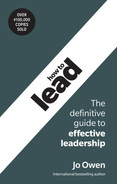chapter 19

Handle conflicts
There are conflicts in the best-run organisations. The leader should be highly suspicious if there is no conflict, because organisations are set up for conflict.
Let’s emphasise this point. In any organisation there is a limited pot of money, management time, skills and resources. Different products, functions and regions will inevitably have different perspectives and priorities. They are all bidding for the same limited resource pot. The ensuing bidding war between departments may be civilised or it may be underhand, political and nasty. In any event, there is a contest and a conflict going on. For many leaders in the middle, the real competition is not in the market place – it is sitting at a desk nearby, competing for the same resources and the same promotion.
“The real competition is not in the market place – it is sitting at a desk nearby.”
Even within your team you should expect conflict. Constructive conflict is a sign of a healthy team. It shows that instead of conformist groupthink, you have a team with different skills and views, and that your team is ready to challenge each other and you – where required. Lack of conflict implies you have a team of conformist yes-men who all think alike.
If we recognise that conflict is a natural fact of life in any organisation, we can take the first step towards dealing with it. Conflict is not about people or personalities; it is about positions and priorities. I asked all our leaders how they dealt with conflict. They all homed in on the same set of principles:
- •Never avoid conflict: embrace it. Conflict is how priorities are set and decisions are made. It develops the leadership and interpersonal skills of the emerging leader.
- •Depersonalise the conflict: never take conflict personally, even if it is meant that way. Focus on the issues and interests at stake, not the personalities.
- •Detach yourself: observe what is happening and do not get emotionally involved. Lose your temper; lose the argument. Think how a leader or role model you admire would handle the situation. One leader called this ‘putting on the mask of leadership’. You may have boiling emotions inside, but present the mask of your ideal leader and use that to guide your actions.
“Lose your temper, lose the argument.”
Occasionally, some conflicts do become emotional and unpleasant – humans, unlike computers, do have emotions. These events are rare but dangerous. If they are mishandled, even the innocent party becomes tainted by the event. At times like this, a simple model helps as a guide. Try to remember this: FEAR to EAR.
FEAR stands for the natural reaction to outright hostility. It also stands for how we feel before seeing the CEO for the first time. It was a helpful emotion when our ancestors faced a sabre-toothed tiger: it would alert them to fight or flight. Fighting or fleeing at the first sight of the CEO is not helpful.
The wrong response is to let FEAR take over, as follows:
- •Fight furiously.
- •Engage enemy emotionally.
- •Argue against anyone.
- •Retaliate, refute, repudiate reason.
If it is your last day at work, using FEAR is a good way to go down. However, take the F out of FEAR and you are left with EAR, which is what you should use to start listening. EAR stands for:
- •Empathise.
- •Agree the problem.
- •Resolve the way forward.
“Win a friend, not an argument.”
The temptation is to go straight to resolving the way forward. This simply invites more argument; the other side will knock down anything you say. You need to calm them down. Empathise with them. This does not mean hugging them – it means using active listening skills, which we will cover later. As you listen, you will find out more about the real nature of their difficulty and why they feel so threatened. Do not try to argue; try to understand. Win a friend, not an argument. Once you have won a friend, you have a chance of winning the argument if there is any substantive disagreement beneath the emotional froth. You cannot begin to find a solution until you have found the problem you both can agree on. Once you have agreed the root cause of the problem together, you have a chance of finding a way forward.
